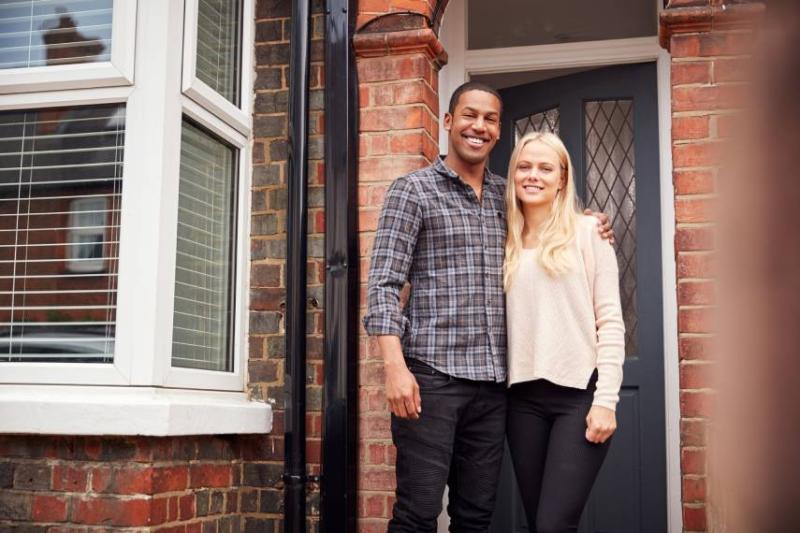
Do you know a terrace from a semi-detached house, or a flat from a maisonette?
We take the guesswork out of it by explaining the key differences between different types of property and consider the pros and cons.
What are the different types of properties in the UK?
There are various kinds of property types in the UK, and some are more similar than others.
We won’t be including mobile homes in this list, but please take a look at our explainer on caravan insurance if you’re curious about this kind of cover.
So, what types of property should you be aware of?
Please check the bottom of this article to find our sources for the statistics mentioned.
What’s a terraced house?
A terraced house is a row of attached properties that share common walls with neighbours.
They’re common in the UK, especially in urban areas, as terraced construction saves a lot of space.
One of the main advantages of terraced houses is that the space saving means they can occupy urban areas where land is at a premium which also makes them more affordable.
The disadvantage of having houses shoulder-to-shoulder is that you often sacrifice privacy.
While the cost of terraced houses varies depending on numerous factors – particularly location – they’re usually the cheapest type of house to buy on average.
According to GOV.UK, in March 2024 the average terraced house in the UK cost £230,406. In London, the average was £561,000 compared to £166,349 in Wales.
What’s a mid-terrace house?
A mid-terrace house is a house in the middle of a row of similar houses. A mid-terrace house shares a common wall with the neighbours on both sides.
What’s an end-of-terrace house?
The end-of-terrace house is at the end of a row of joined properties. This means it only shares one common wall with a neighbour.
You’ll usually find these at the end of a street or cul-de-sac.
They’re only joined to one other property, so they tend to be a little more expensive than the other houses in the same terrace.
They may also have a larger garden, depending on the design.
What’s a semi-detached house?
Semi-detached houses are the most common type of property in the UK.
These are two properties linked to each other with a common wall. Semi-detached houses usually have a mirrored layout.
A big advantage of living in a semi – especially compared to a mid-terrace – is that there’s usually more privacy, plus sharing only one common wall with neighbours is likely to reduce the amount of noise you can hear.
They’re also much more affordable than fully detached houses, on average. In March 2024, the average price of a semi in the UK was £275,684 (going up to £ £671,000 in London), and in Wales it was £209,039.
What’s a detached house?
Detached houses, as the name suggests, aren’t connected to any other buildings. These are standalone structures, and often have both a front and a back garden.
One of the main advantages is that this type of property is usually more private than other kinds of houses.
This means that, when undergoing work such as home improvements, having to consider the neighbours is often not an issue.
However, standalone living usually comes at a cost. Detached houses are more expensive than terraced and semi-detached houses on average.
In March 2024, the average detached house in the UK would set you back £440,085 (according to GOV.UK).
What’s a link detached house?
A link detached house doesn’t share any common walls with another house or property, but it’s linked to another property – normally via a garage.
So, both properties will have some foundations in common.
There are certain advantages to living in a link detached house. You’re less likely to be affected by any noise your neighbour makes than you would in a semi.
However, if one of you plans to build an extension above the garage, it requires the neighbour’s permission, and construction should be in accordance with the Party Wall etc Act 1996.
The same can happen if you share a driveway as neighbours may not agree on plans like building gates.
Property value is a consideration here, as the neighbour giving up the driveway is likely to see their house price drop.
So, when working out a price, it’s important to work out a cost which is fair for both homes.
What’s a bungalow?
A bungalow is a single-storey property which is ordinarily detached from other properties but are smaller than the average detached house.
In 2023, the average bungalow in the UK cost £330,000, according to Statista.
It’s also possible to get chalet bungalows (also known as dormer bungalows), which have dormer extensions in the roof. These effectively make the property a storey and a half high.
What’s a cottage?
A cottage is hard to define. While most of us can easily visualise one – thatched roofs, casement windows, low ceilings - they have changed numerous times throughout history.
Today, the term refers to a small house, usually found in the country. Their appeal as a holiday home investment has inflated costs meaning the asking price can be high.
What’s a mansion?
The definition of a mansion is debatable.
A lot of it depends on where you are. The dimensions and characteristics of a mansion in Los Angeles will be larger than one in Cardiff, for example.
As a rule of thumb, a mansion is roughly 5,000 square feet, though in some places, it can be up to 8,000.
The housing market in an area can influence the definition and how real estate professionals choose to market the property.
In general, mansions are very large properties with many rooms, a large garden and often a pool or other eye-catching features.
They’re the most expensive houses around, as well as one of the rarest available.
What’s a flat?
Flats (or apartments) are separate, self-contained properties in one building. Each flat has its own address and front door, but generally shares a corridor.
The two main types of flats are purpose-built, such as with blocks of flats, and existing residential properties which have been divided up into flat.
One of the main advantages of flats is they’re usually more affordable to buy or rent than entire houses.
In the case of tenants, people are often able to rent in locations where buying a property wouldn’t be affordable.
The downside of flats is the lack of privacy. This can be problematic when it comes to noise carrying between floors, for instance. There are more things to consider when buying a flat, too.
In March 2024, the average flat or maisonette in the UK would cost you £229,813 (according to GOV.UK).
What’s the difference between a flat and an apartment?
You may know “flat” as the British variant and “apartment” as the American. However, there are structural differences between flats and apartments.
A flat is usually found across one floor. An apartment, however, can span across multiple floors, and can sometimes be used to describe a more upmarket, higher-quality flat.
What’s a maisonette?
A maisonette – French for ‘small house’ – is like a flat because it’s one of multiple properties in a building.
However, it has a separate entrance rather than a shared main entrance and separate front door.
A maisonette can be a single storey or split over a few levels, and it also has its own address.
Home and landlord insurance for every type of home
If you’re a first-time buyer or want to know things to look for when viewing a property, read our guide to house viewings.
Whether you’re a first-time buyer or looking for a second property to rent, it’s important to have the right insurance to protect you.
Find out more about our home insurance if you’re buying for yourself, or our landlord insurance if you’re looking to rent out your property.
All house prices used in this article:


